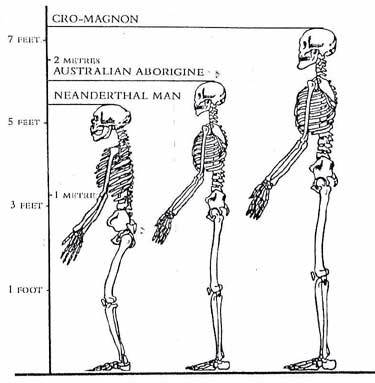I wouldn't say quite that we evolved from apes, but that modern apes and humans evolved from a common/shared ape-like ancestor that we split off from tens of millions of years ago. Many primatologists group humans -- including us and the now-extinct neanderthals (which some consider to be a sub-species of modern humans) -- with the Great Apes (chimpanzees, bonobos, gorillas, organgutans), each species of which branched off from that common/shared ancestor to gradually come to its current form.
For brain size" When I was doing some grad studies in biology -- with a focus on primate evolutionary ecology -- my paleoanthropology prof brought in skull casts of modern humans from around 28,000 years ago and 6,000 years ago, and of neanderthals and Homo erectus (AKA Homo ergaster) skulls from China that dated back around 300,000 years. What was remarkable was the size of the brain case in both neanderthals and H. erectus. The brain cases of the neanderthal skulls we held, were larger than those of the modern humans' (including our own). The brain cases of the H. erectus skulls were somewhat smaller than ours, but still quite substantial compared to chimps and gorillas. H. erectus first appeared about 1.8 million years ago, according to the fossil record. They created stone tools, which is a sophisticated task that requires manual dexterity, are believe to have been the first hominids to have lived in bands (cooperative hunting), and there is strong evidence that they used fire, which really requires intelligence and insight!
For brain size" When I was doing some grad studies in biology -- with a focus on primate evolutionary ecology -- my paleoanthropology prof brought in skull casts of modern humans from around 28,000 years ago and 6,000 years ago, and of neanderthals and Homo erectus (AKA Homo ergaster) skulls from China that dated back around 300,000 years. What was remarkable was the size of the brain case in both neanderthals and H. erectus. The brain cases of the neanderthal skulls we held, were larger than those of the modern humans' (including our own). The brain cases of the H. erectus skulls were somewhat smaller than ours, but still quite substantial compared to chimps and gorillas. H. erectus first appeared about 1.8 million years ago, according to the fossil record. They created stone tools, which is a sophisticated task that requires manual dexterity, are believe to have been the first hominids to have lived in bands (cooperative hunting), and there is strong evidence that they used fire, which really requires intelligence and insight!
Yeah the 20 million is totally wrong, but you got my point. Still, since it's said that these early humans from 200,000 had the same brain capacity and intelligence as we do today, surely they'd have done something a little more interesting than make a spear, drill a hole in a shell, and paint a picture for us to find a bit sooner than 75,000 years ago. I don't really question whether or not evolution has great evidence, only the timelines. And I think the Sphinx is indeed VERY much older than the Egyptologists would have us believe. Again, their timeline doesn't match the evidence.
I still hold that it's theory that we evolved from apes. I think it's pretty likely, but it's still not absolute proven fact and shouldn't be presented as such.




